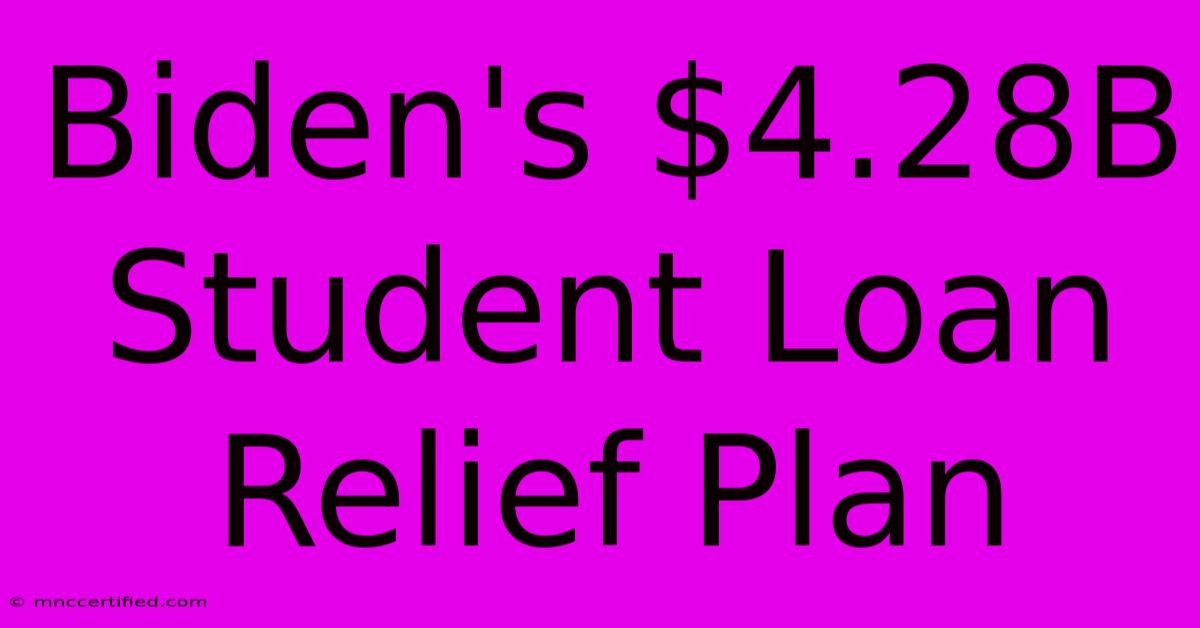Biden's $4.28B Student Loan Relief Plan

Table of Contents
Biden's $4.28 Billion Student Loan Relief Plan: A Comprehensive Overview
President Biden's student loan forgiveness plan, initially announced in August 2022, aimed to provide substantial relief to millions of Americans burdened by student loan debt. While the plan ultimately faced legal challenges and was eventually blocked by the Supreme Court, understanding its details and impact remains crucial for anyone affected by student loan debt. This article provides a comprehensive overview of the now-defunct plan, exploring its key features, eligibility criteria, and the subsequent legal battles that led to its demise.
Key Features of the Proposed Plan
The plan proposed to cancel up to $20,000 in student loan debt for Pell Grant recipients and up to $10,000 for non-Pell Grant recipients. This targeted approach aimed to provide more significant relief to those from lower-income backgrounds who often rely on Pell Grants to finance their education. The plan specifically targeted federal student loans, excluding private loans.
Eligibility Requirements
To be eligible for the proposed loan forgiveness, borrowers had to meet several criteria:
- Income Limits: Borrowers' annual income needed to be below $125,000 for individuals or $250,000 for married couples. This income threshold aimed to focus relief on those who needed it most.
- Federal Student Loan Holder: Only borrowers with federal student loans held by the Department of Education were eligible.
- Application Process: Borrowers were required to complete a simple application process through the Department of Education's website. While initially expected to be straightforward, this process also became a point of contention during the plan's implementation.
The Legal Challenges and Supreme Court Ruling
The Biden administration's student loan forgiveness plan faced significant legal challenges almost immediately after its announcement. Several states argued that the plan exceeded the Secretary of Education's authority under the HEROES Act of 2003, the law the administration cited as its legal basis.
The Supreme Court ultimately heard the case and ruled against the administration, stating that the HEROES Act did not grant the Secretary of Education the broad authority to enact such a sweeping student loan forgiveness program. This decision effectively ended the plan.
Impact and Aftermath of the Plan's Failure
The failure of the student loan forgiveness plan left millions of borrowers without the anticipated relief. The decision sparked widespread debate about the future of student loan debt in the United States and the role of government intervention in addressing this significant financial burden.
Several alternative approaches to student loan debt relief are currently being debated, including:
- Income-Driven Repayment (IDR) Plans: Strengthening and expanding access to IDR plans to make monthly payments more manageable for borrowers.
- Targeted Loan Forgiveness Programs: Implementing more narrowly targeted loan forgiveness programs based on specific criteria.
- Increased Funding for Higher Education: Investing more in higher education to make college more affordable and reduce the need for significant borrowing.
SEO Keywords and Optimization
This article utilizes several relevant keywords, including: Biden's student loan forgiveness plan, student loan relief, $20,000 student loan forgiveness, $10,000 student loan forgiveness, Pell Grant, federal student loans, student loan debt, HEROES Act, Supreme Court ruling, income-driven repayment, and student loan relief programs. These keywords are naturally integrated into the text to improve search engine optimization (SEO) without sacrificing readability. Further off-page SEO strategies would include promoting the article through social media, linking to reputable sources, and building backlinks from other relevant websites. The use of headers, bold text, and a clear structure also enhance readability and SEO.

Thank you for visiting our website wich cover about Biden's $4.28B Student Loan Relief Plan. We hope the information provided has been useful to you. Feel free to contact us if you have any questions or need further assistance. See you next time and dont miss to bookmark.
Featured Posts
-
Zoe Balls Last Radio 2 Breakfast Show
Dec 21, 2024
-
Biden On Student Debt Final Round
Dec 21, 2024
-
Yellow Weather Warning Sunday Storm Update
Dec 21, 2024
-
Bitcoin Falls To 96000 Amid Market Volatility
Dec 21, 2024
-
Tulane Florida Gasparilla Bowl Time And Tv
Dec 21, 2024